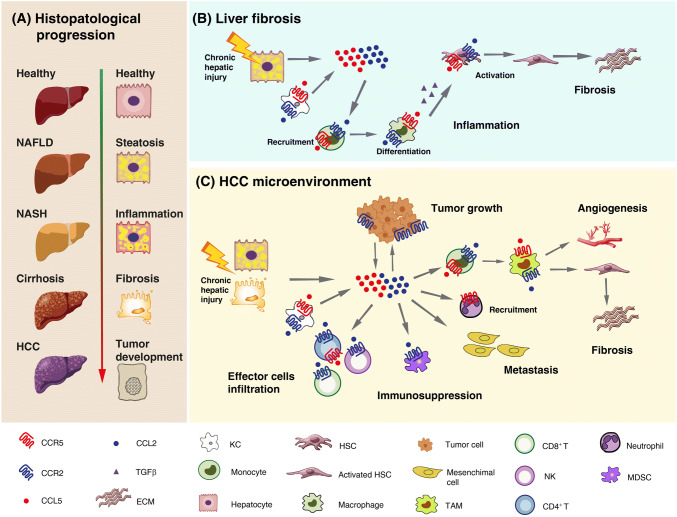Fig. 3.
Schematic model of the role of CCR5 and CCR2/CCL2 in liver fibrosis and tumor development. a Hepatocyte histological changes during the progression from a healthy liver to non-alcoholic fatty liver disease (NAFLD), non-alcoholic steatohepatitis (NASH), cirrhosis and hepatocellular carcinoma (HCC). b Contribution of CCR5 and CCR2/CCL2 to the major pathogenic events leading to liver inflammation and fibrosis. Activated Kupffer cells (KCs) and damaged hepatocytes secrete CCR2 and CCR5 ligands, which mediate monocyte recruitment, their differentiation into macrophages, and activation of hepatic stellate cells (HSCs), thus contributing to inflammation and extracellular matrix (ECM) deposition. c Contribution of CCR5 and CCR2/CCL2 to HCC progression. In the tumor microenvironment, CCR2 and CCR5 ligands secreted by KCs, damaged hepatocytes and tumor cells promote tumor growth and mediates monocyte recruitment and their maturation into tumor-associated macrophages (TAMs) with pro-angiogenic and pro-fibrotic features; the infiltration of myeloid-derived suppressor cells (MDSCs), thus contributing to immunosuppression; the progression of primary tumors towards metastases by promoting the migration, invasion and epithelial–mesenchymal transition of HCC cells. On the other hand, these chemokine axes also promote the infiltration of effectors cells, which contributes to tumor eradication

